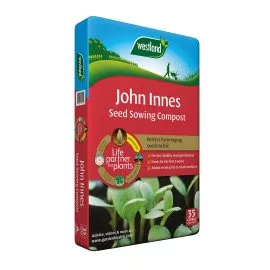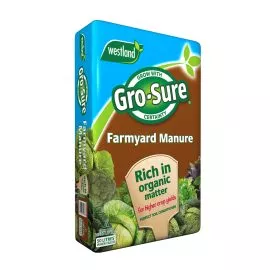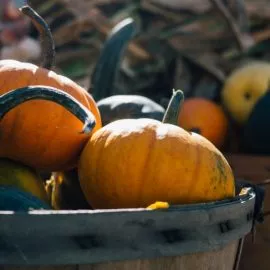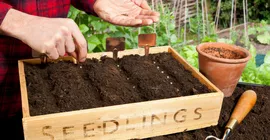Pumpkins are simple to grow and the fruits store well in a cool dry conditions. Great for growing with kids and delicious roasted or used for making soups. They’re full of nutrients too; did you know pumpkin seeds are a super-food? This has made this easy to grow plant very popular with gardeners.
Read our step by step advice below to learn more:
Sow indoors
For earlier crops, sow pumpkin seeds indoors in 7.5cm pots from mid- to late April. Sow the flat seeds on their side, 1cm deep, and keep them at 18–21°C
Sow outdoors
- You can also sow seeds directly outdoors where you want them to grow. Sow two or three seeds per planting hole, 3cm deep, in late May or early June.
- Cover with cloches, jars or plastic sheeting
- Leave this in place for two weeks, or as long as possible, after germination
- Thin the seedlings, leaving only the strongest one to grown on
Pumpkins require a warm and sunny position in your garden with shelter from cold winds. It also benefits from having moisture-retentive soil.
1. In late May, you can start hardening off indoor-raised plants in order to acclimatise them to outdoor conditions. Do this by moving them into a coldframe for a week. If you don’t have a coldframe, move plants outdoors during the day, then simply bring them in at night for about a week. The following week, leave them out in a sheltered spot all day and night.
2. Plant them out in early June, when all risk of frost has passed.
3. Before transplanting indoor-raised plants or sowing seeds outdoors, ensure you prepare the planting site by making a hole about a spade’s depth and width.
4. Backfill with a mixture of compost or well-rotted manure and soil. Sprinkle a general purpose fertiliser, at a rate of two handfuls per sqm and space 1.8m (6ft) apart. Pumpkins require a generous amount of room to grow.
You can also plant pumpkins in growing bags . Plant one or two per growing bag and water generously
Pumpkins need plenty of water. Once you see those first fruits starting to swell they will also require feeding every 2 weeks with a high potassium liquid fertiliser, a tomato feed like Big Tom is perfect for this.
Step 1

How to sow: Pumpkins have large seeds that need soaking overnight before you sow. If you want to harvest early in July, then sow indoors from April and put outside in June. They do best when planted directly into the ground. For regular harvesting (July – October) sow outdoors in May or June once the soil has warmed up. They should take about a week to germinate. They prefer a sunny sheltered position.
Step 2

Indoor sowing: Place in a 9cm pot filled with Westland John Innes Seed Sowing Compost on its side. Once germinated it should produce two or three leaves and then it’ll be ready to harden off during the day outside and brought in at night.
Outdoor sowing: Prepare the soil and sow 3 seeds together at 3cm depth, one metre apart. They need space!
Handy tip: Dig a medium size pot into the soil next to each plant and use this to water the plant. This will ensure the plants don’t rot but the roots get enough water.
Step 3

Growing: As they grow, remove the weaker plants so that you are left with one strong plant. You’ll need to protect them from slugs and snails so consider putting slug pellets down like Eraza Zero Slug Killer which contains a natural ingredient so can be used with edible plants.
If you’ve chosen trailing varieties you’ll need to pinch out the tips of the main stems when they reach about 2 feet in height to promote side shoots and flowering – this is what produces the fruit. Pumpkins need to be kept well-watered but avoid getting the leaves wet. Add a mulch like Gro-Sure Farmyard Manure and start feeding with Big Tom Super Food once the fruit starts to swell every 1-2 weeks.
Step 4

Harvesting: Pumpkins are generally ready to harvest come September. To help them ripen up, cut back all of the green foliage a few weeks before you intend to harvest the fruit. When ripe, pumpkins display their familiar orange colour but you can check for ripeness by giving them a tap – they should sound hollow or checking the stem and skin which should have hardened. When picking use a sharp knife rather than breaking off by hand to minimise diseases and prevent skin rash.




